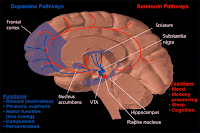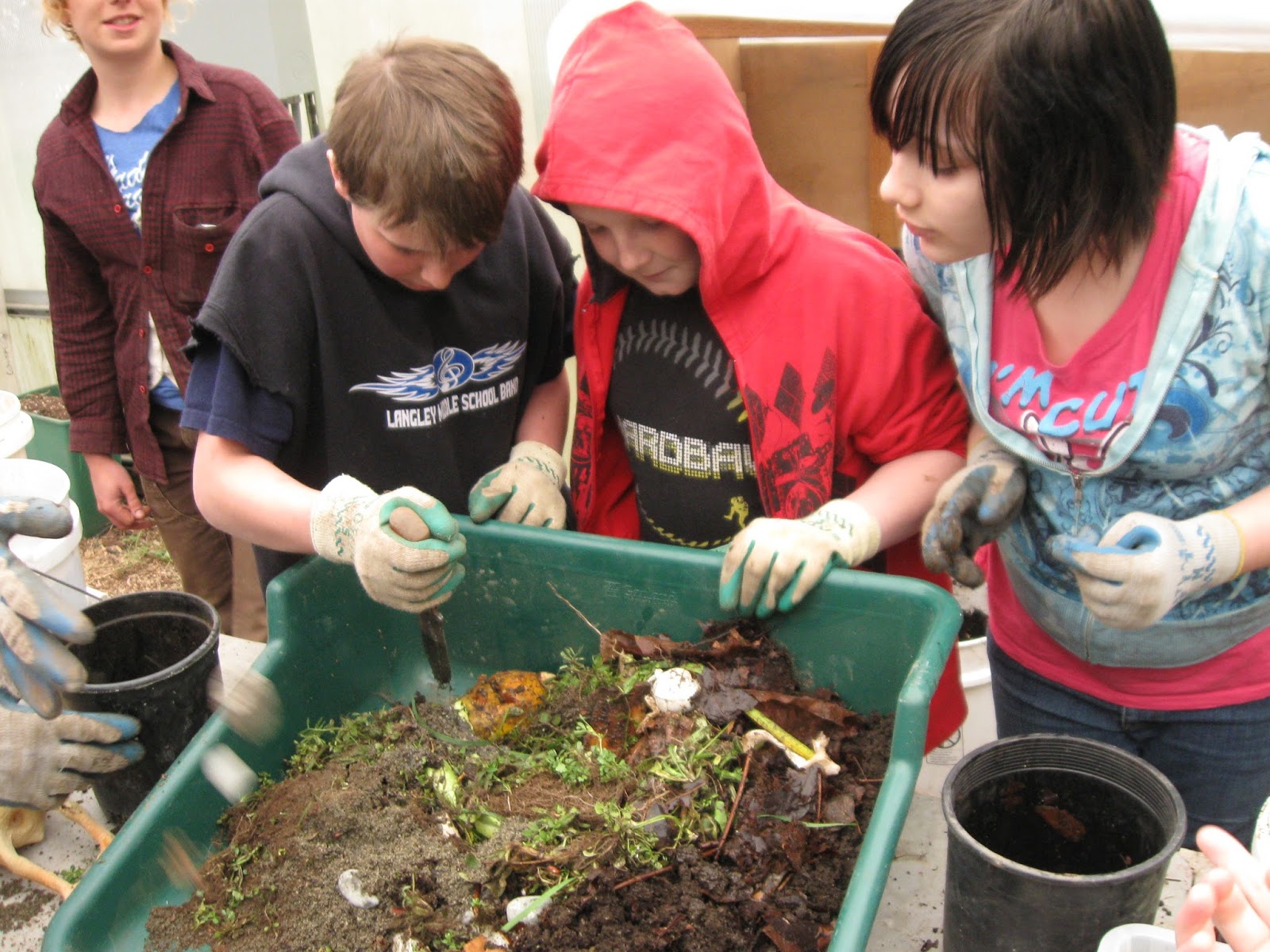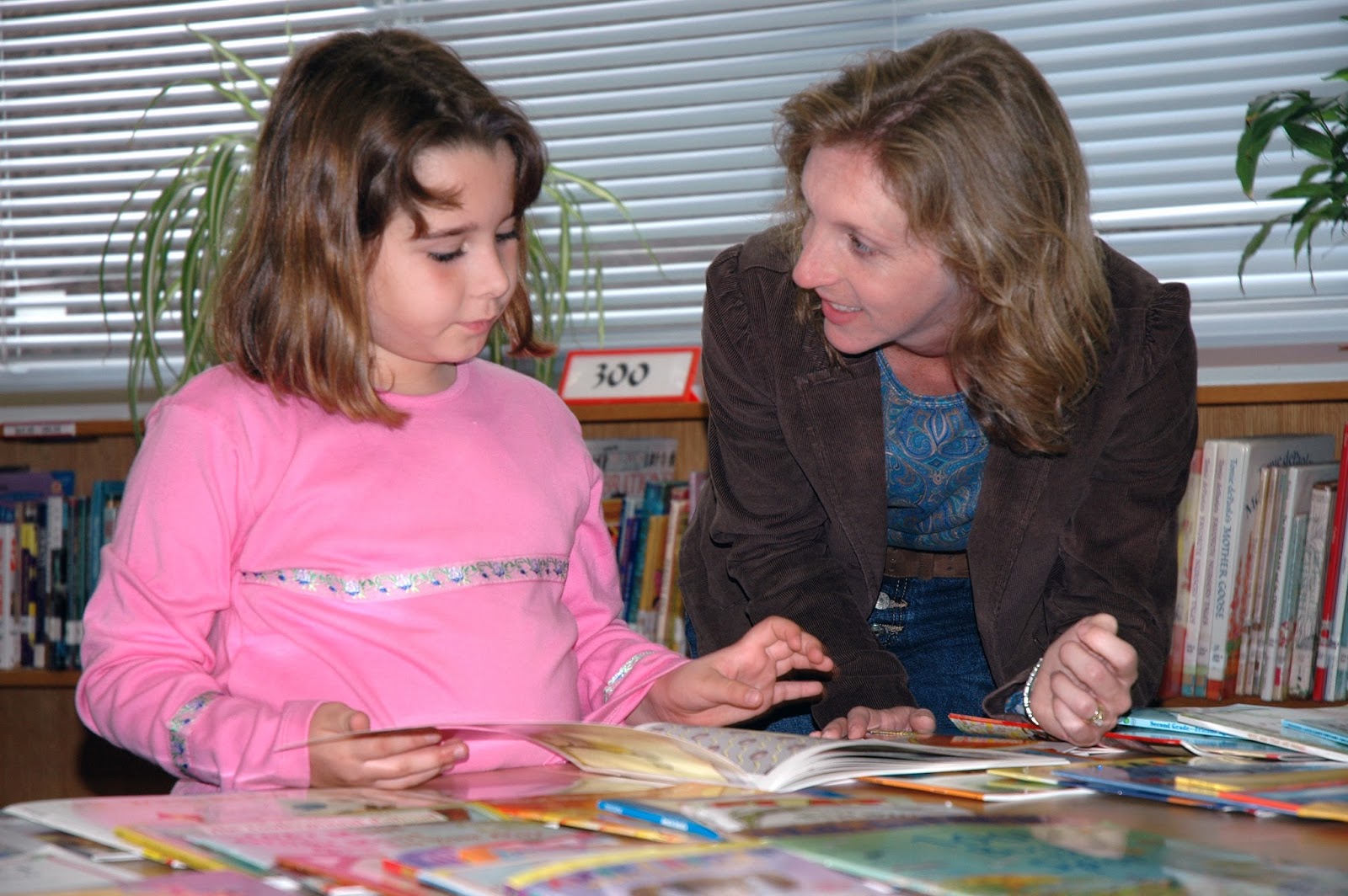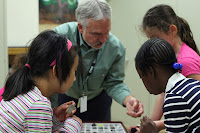Introduction & Goals
 |
| montessoriguide.org |
It is the goal of this website to reveal the associated benefits
of group pedagogy to help schools function at their highest level. In many instances
classrooms are not allowing students to use their full cognitive potentials
because a large proportion of the time involves sitting and observing: the teacher
lectures, presents slides, or passes out worksheets. Even when these are done in
an efficient manner, the process is not incorporating the realm of the human social
dynamic that arouses thought, creativity, and the motivational areas of the
brain.
What has research determined? It is beneficial to have
students included in discussions, especially if they are positioned to have eye
contact and offer a significant number of contributions to the discussion.
Student participation at the board to analyze problems and even lead a discourse
is another way to maximize student involvement.
More significantly, however, students sitting in groups of
three to five in close proximity with explicit instructions and guidelines outperform
their counterparts in teacher-led lecture classes. The cooperative setting (even
as part of a larger classroom instruction program) promotes tolerance and
motivation to learn as well. The prefrontal cortex-midbrain connection is repeatedly
stimulated in such settings and the growth of dendritic connections to nerve
cells is increased. The consequence is better long-term mastery of subject matter
and skills. In addition, the spontaneous social engagement encourages what our
society strongly desires in our citizens: tolerance and altruistic behavior.
This site discusses these topics and includes the studies
and commentaries from researchers in the areas of neurology, education,
sociology, and business. Specific instructions are given on (a) how schools can
improve their 'priming' to make the environment more conducive for learning as
well as (b) classroom procedures that maximize concentration and higher level
thinking such as analysis and creativity.
Brian Pack
packb@uwm.edu
1) The brain can be easily manipulated and primed
 |
Secure Base Priming
My wife and I are enjoying the many
moments with our grandson because we babysit most days while his parents are
working. We think he is the most wonderful event to occur in our lives
since our two sons were born. Seeing posts of him on Facebook gives us joy and
we have arranged our lifestyle around his needs.
Yet, at the same time, there is a
lot to be depressed about as our city is undergoing a murder rate at a level
never achieved in its history. This is a pattern across the nation. All kinds
of horrible assaults are being made visible on television. Bad people are
stealing and hurting ordinary citizens daily. International affairs are
outright calamitous, too, including many geological calamities. I suppose I could
simply avoid the print and broadcast news but that would be like putting
my head in the sand. It is depressing.
However, just seeing our grandson's
picture warms our hearts and makes life worth living. I'm more motivated to
accomplish tasks because of it. Pictures of my late father and relatives on our
walls have a similar effect as well. Coming across artifacts such as letters of
these relatives produces a warm feeling, too. In fact our pet beagle Sparky had
the same affect when he was living.
What is happening here?
Priming
I am being primed. In other words
observing pictures of people (or even pets) that I put trust and found love in
my childhood creates a positive mental state out of a no-mood or even depressed
state. Those images go into my emotional memory bank and elicit a positive
mood. That mood is motivating and helps me take a fresh perspective on life and
motivates to get things accomplished.
I believe this is the oxytocin
effect. Oxytocin, a hormone, is released in association with maternal behavior
such as child birth and breast-feeding but also in both genders in the areas of
commitment, romantic attachment, and calm feelings. Those feel-good memories
essentially trigger the secretion of oxytocin and creates the feel-good
sensation. That is good because it also reduces the activation of the
fear-sensitive amygdala that lessens a person's capacity to be social with
others. [2]
If it works so easily in my home,
will priming do the same thing in the classroom, that is, generate a mood conducive
to learning or any setting for that matter? It can and there have been
scientific studies that verify that priming alters perceptions related to
tolerance and mood.
Research to validate
effects of priming
One was led by Professors of
Psychology Mario Mikulincer and Phillip Shaver. Participants were divided into two groups that were 'primed' with certain words subliminally by reading content on a computer screen.
-One group saw an abundance of 'neutral' words: (office, table, boat, and picture).
-The other group saw an abundance of emotionally secure words: (closeness, love, hug, and support).
-They then read the resumes (gender, age, marital status, and national origin) of two students sitting across from them. [2]
-One group saw an abundance of 'neutral' words: (office, table, boat, and picture).
-The other group saw an abundance of emotionally secure words: (closeness, love, hug, and support).
-They then read the resumes (gender, age, marital status, and national origin) of two students sitting across from them. [2]
The participants were then asked to
evaluate, using a checklist, the two students on characteristics
such as positive (honest, cheerful, reliable, warm, patient) and negative
(argumentative, sleazy, spineless, impulsive, lazy).
The result? The participant that read
the neutral words evaluated the student of similar national origin favorably but
rated the student of different national origin unfavorably.
On the other hand the participant
that read the emotionally secure words evaluated both the students of similar and divergent national origin
favorably.
That simple.
In fact, Mikulincer used
participants of different emotional attachment personalities: secure, avoidant,
and anxious and got similar results throughout. Avoidant and anxious
individuals are particularly prone to demonstrate less tolerance based on
racial and political backgrounds. However, the experiment showed that even
those with avoidant or anxious rearing could be primed to have secure feelings.
Conscious security
prime
To test the priming method further,
they had 120 student volunteers rate their willingness to interact with what they would consider socially
incompatible people. Instead of the subliminal word list the volunteers of
asked to simply visualize themselves “in a problematic situation that you
cannot solve on your own, and to imagine that you are surrounded by people who
are sensitive and responsive to your distress, who want to help you because
they love you, and set aside other activities in order to assist you.” It was
not a subliminal but rather a conscious security prime. [3]
The neutral prime was to imagine
yourself going to a grocery store and buying products you need for your house,
and imagine other persons buying products, talking among themselves about
ordinary issues, examining new brands, and comparing different products.
Though similar to the bias finding
in the previous study, the participants were to instead decide whether or not
they would be willing to invite a socially incompatible individual to their
home and join them when they went out with friends.
The result? The participant would
opt to invite the socially incompatible individual to either their home or go
out with friends if they had been primed with the emotional comforting thoughts
first. Those participants that were primed consciously with the neutral
statements hesitated in their desire to include a socially incompatible person
to their home or go out with friends.
Shaver concluded that even though a
person could have “attenuated derogatory reactions to out-group members or to
targets that threatened the participants' worldview… having a sense of being
loved and surrounded by supporting others seems to allow people to open
themselves to alternative worldviews and be more accepting of people do not
belong to their own group.”
Even with avoidant and anxious
personalities there is a temporary activation of attachment security to become
outwardly accepting and tolerant. It gets interesting with what Mikulincer and
Shaver did next.
Priming and altruism
In another priming procedure,
individuals had the option to substitute for another person that was performing
peculiar actions such as petting a laboratory rat, putting their arm in ice
water, touching a tarantula or a preserved sheep's eye or a snake, or let
cockroaches crawl up their arm. Avoidant and anxious personalities were
reluctant and declined to step in to perform the remaining actions. However,
those individuals that were primed to think about “….someone who wants to help
you because they love you….” expressed compassion and even a willingness to
step and complete the awkward tasks even for the most avoidant and anxious
personalities. [3]
The thought-prime triggered
altruistic compassion within the conscious mind. It made every participant
feel more secure, willing to do something about another's suffering.
What happened here? By priming the
brain with emotionally secure words people with a wide range of personalities
had spontaneous moments of tolerance. It is the oxytocin effect mentioned
earlier. Apparently the subliminal and conscious primes worked in the
prefrontal cortex-amygdala network in individuals and rekindled the feel-good
memories. The prefrontal cortex memory bank experienced a rekindling of
compassion from thoughts in an earlier part of life and quieted the
fear-sensitive amygdala to allow the person to negate prejudice and even create
a state of altruism.
The media is priming
all of us
As parents and educators we have to
be concerned with the 'primes' our children experience every day. Where do they
come from? At home and school of course but a sizable amount from the media.
While some of it is seemingly benign and beneficial like Sesame Street,
many channels are geared for adult eyes, with adult themes, with adult
actors. The Food Channel and Home and Gardens Network provide interesting
programming but there is so much more that is X-rated on cable networks and
accessible to everyone.
Here's a small sample of the
incidents captured between Jan. 11 and Feb. 11, 2013:
-A character on ABC's "Body of
Proof" says he dreams of ripping a woman's brain out while she's still
alive, but he's shot as he's about to stick a hook up her nose. Then he's
pushed off a balcony and killed.
-A prison riot episode of CBS'
"Hawaii Five-O" includes one man trying to kill someone in a laundry
room press, a man snapping someone's neck with his legs and a man injected with
something that causes a violent convulsion.
-A gun fight on ABC's "Last
Resort" is ignited by one man stabbing another in the abdomen with a
screwdriver.
-A man on CBS' "Criminal
Minds" is shot dead by the FBI as he tries to cut the eyelids off a
gallery owner's face.
-Two characters on Fox's
"Bones" wake to find a corpse hanging from the canopy above their
bed, dripping blood onto them.
-An already bloody man is dragged
into a warehouse on CBS' "The Mentalist," choked to death and thrown
in a furnace - all witnessed by a little boy hiding in the building.
-A man writhes in pain on Fox's
"Fringe" before a parasite violently bursts out of his body. He's
surrounded by the bodies of others who had met the same fate.
-A scene in ABC's "Grey's
Anatomy" features a woman's nightmare about sawing her leg, as blood
spurts and she screams in pain.
-A gymnastics coach is stabbed several
times in the groin on NBC's "Law & Order: SVU."
-A man working on a coffee cart on
"The Following" is doused with gasoline and burned alive. [4]
The media influence has been studied
as Brandon Centerwall, writer and Psychiatrist in Seattle, Washington notes:
“while children have an instinctive desire to imitate, they do not possess an
instinct for determining whether a behavior ought to be imitated. They will
imitate anything, including behavior that most adults regard as destructive and
antisocial. The evidence indicates that if, hypothetically, television
technology had never been developed, there would be 10,000 fewer homicides each
year in the United States, 70,000 fewer rapes, and 700,000 fewer injurious
assaults. Violent crime would be half what it is.” [5]
Also, in a report from The American
Psychological Association Commission on Violence and Youth: “….violence is not
a random, uncontrollable, or inevitable occurrence. There is absolutely no
doubt that higher levels of viewing violence on television are correlated with
increased acceptance of aggressive attitudes and increased aggressive
behavior.” [6]
What can we take from this as parents and educators?
 |
wikimedia.org |
Why? Because media
culture has inculcated representations of humans as sexualized, angry,
vindictive, manipulative, shallow, disrespectful and violent. Screen writers
are trying to outdo the competition, and the stakes are raised to escalate the
sexualization and violence to grab your attention. Students come into schools,
therefore, with a sufficient amount of negativity and confused adult
role-modeling behavior – all for the sake of the media to entertain the masses
and compete with shows to be more extreme than the next.
That
mindset may not
find you, a normal citizen, to be as captivating as the well-scripted
people on
the television screen. Only with a special effort as a school and
particularly teachers does the education process work, and is derailed
at
times even before the bell rings, in its ability to transmit content to
the level
desired by school and classroom expectations.
Admittedly many
students do not view the adult-themed programs, but there still is an
entertainment industry that wants to win over your children just like MacDonald's
does with Happy Meals, and there is little accountability as these adult themes
are getting PG-13 or even G ratings.
Teachers that role
model compassion and are explicit about their goals are doing a great service to
counteract the ever pervasive and morbid projections of the entertainment and
advertisement industry.
What can schools do
to create the 'primes' to minimize the effect of the entertainment culture?
What is needed to elicit the mood to learn and to work cooperatively with the
teachers and peers? I'll list a few here.
1. Make the first
day of school count. Have an opening assembly where the principal or others talks
about values and expectations. Discussion should be explicit about the
significance of education in the life of students, the concern the school has
for the well-being of each and every one of them, and the need to treat
everyone with kindness.
2. Post pictures of
famous role models throughout the building with quotes and captions describing
their success in life, especially the person the school is named.
3. Have at least one
value quote that is central to the school's mission on the building's exterior.
4. Have assemblies
that honor students for their accomplishment and allow student musicians and
vocalists to perform. Have a teacher or principal express gratitude for the
performance in front of the audience.
5. Have back-to-school
nights and coffees for the parents and inform them about school values that are
expressed to the students. Talk about accomplishments. Let them see trophies and the wall hangings
of the role models. State, too, how each student is valued by the faculty and
administration. Try to keep the program moving to minimize personal parent agendas.
Have a few students do instrumental presentations.
6. Promote community
service opportunities.
7. Have honorary
assemblies for the custodians and kitchen staff.
8. Send commendation
letters home when students do something above and beyond.
9. Demonstrate
compassion and acts of altruism in the adult community of the school.
References
[1] Lee HJ, Macbeth AH, Pagani JH, Young WS (June 2009).
"Oxytocin: the great facilitator of life". Prog. Neurobiol. 88 (2):
127–51
[2] Mikulincer, M., Shaver, P., “Attachment Theory and intergroup bias: evidence that priming the secure base schema attenuates negative reactions to out-groups." Journal of Personality and Social
Psychology, 2001, Jul;81(1):97-115.
[3] Mikulincer, M., Shaver, P., Gillath, O., and Nitzberg, R., "Attachment, Caregiving, and Altruism: Boosting Attachment Security Increases Compassion and Helping", Journal of Personality and Social Psychology, 2005, Vol. 89, No. 5, 817–839
[3] Mikulincer, M., Shaver, P., Gillath, O., and Nitzberg, R., "Attachment, Caregiving, and Altruism: Boosting Attachment Security Increases Compassion and Helping", Journal of Personality and Social Psychology, 2005, Vol. 89, No. 5, 817–839
[4] David Bauder, Litany of Horrors, Seattle Times, 2013
[5] Centerwall, B., “Television and Violent Crime”, The
Public Interest, 1993
2) Trust is a crucial element in bringing out the best in people
 |
| blog.newscom |
However, Popovich comments: "Relationships with people
are what it's all about. You have to make players realize you care about them.
And they have to care about each other and be interested in each other. Then
they start to feel a responsibility toward each other. Then they want to do for
each other. I think that communication thing really helps them. It engenders a
feeling that they can actually be in charge."
This is reflected in the fact that veterans Manu Ginóbili and
Tony Parker could have chosen more lucrative contracts with other teams but chose
to re-sign with the Spurs knowing 'Pop' would still be their coach. [1][2]
Popovich in his unique way built a trusting relationship
between the coaching staff and players. His accomplishments in the NBA reflect
on his teaching style. Can elementary
and secondary school teachers gain from his methods? While his pedagogy is
specific for professional athletes we can still find words from his quote to be
relevant: relationships, care,
responsibility, communication, and
being in charge.
The amygdala as the
emotional gateway
Researchers in neuroscience have demonstrated that there are
biochemical processes related to socialization and trust. They have shown that
establishing trust between people leads to positive consequences and betterment
in communities.
The amygdala is sort of the emotional clearinghouse of our
brain. As we mature it, in conjunction with life's recorded experiences,
decides how to process events as they occur moment by moment. It will immediately
send the alarm if a car comes hurtling our way in the middle of an intersection
from the visual stimulus, and within a fraction of a second send signals to the
sympathetic nervous system.
First to get it is the hypothalamus, which then sends out
neurohormones to the pituitary gland, which then sends hormones through the
circulatory system to activate the adrenal glands to produce cortisol and
adrenaline. Both help in the production of glucose, the energy molecule. In an
emergency this sugar is needed to get the muscles poised to move. This fight or
flight response occurs along with rapid breathing, heart rate, and blood
pressure in order run from the potential accident.
In non emergency situations, however, the amygdala 'weighs'
the emotional cost/benefit ratio associated with the circumstance in
conjunction with the cortex, the place that has memories about the stimulus. Often
they are benign and we move on to the next task without tension. However, some of us experience
tension at work, home, or school. These encounters, while not emergencies, are
nevertheless filled with frequent stressful encounters and deadlines, and the amygdala-hypothalamus-pituitary
system keeps the flow of cortisol going. On a continuous basis the cortisol
production has consequences. One is to make sure there is a source of energy
around and the storage of fat is one way to accomplish this. Over a period
of time it ends up noticeably in the midsection and other regions of the body.
The other consequence is the flooding of the memory storage component,
the hippocampus, which under calm situations chemically lowers the cortisol after
a tense experience. The excess cortisol that floats around the circulatory
system in a chronically stressed person, however, floods the hippocampus,
resulting in its atrophy because the memory-developing dendrite formation to
the main axon cells is reduced. That lessens the person's overall memory capabilities.
[3]
Stressed people are
often anxious people.
Think of someone who jumps suddenly when another walks
behind them into a room or even those that have post-traumatic stress disorder,
and hits the floor and covers their head after hearing a loud noise. In
general, an anxious personality starts a metabolic snowball where chemicals are
produced that lead not only to the shrinking of the hippocampus but cell damage
throughout the body. The amygdala becomes hyper-sensitized resulting in a
socialization pattern that is mistrusting and unhappy.
There are a host of biochemicals that affect our thinking
and emotions but oxytocin, a hormone, has caught the attention of researchers
in the trust realm. It is released in association with maternal behavior such
as child birth and breast-feeding but also in both genders in the areas of
commitment, romantic attachment, and calm feelings. When teachers and coaches
call attention to their students' talents and humanity, they trigger a set of
biochemical reactions, particularly the secretion of oxytocin, and along with
it create trust. That is good because interpersonal relationships can be
fearful at times, but stimulating oxytocin flow reduces the activation of the
fear and social-sensitive amygdala.
Furthermore, the prefrontal cortex, a place for long-term
memory storage, will reduce that threatening signal if it remembers that
stimulus as being nonthreatening. Getting up in front of a group to speak, for
instance, is threatening, but after one or more opportunities, that experience may
prove enjoyable because the prefrontal cortex has been conditioned through
repetition that there is no safety hazard in speaking in front of groups.
Oxytocin is secreted in conjunction with that memory and attaches to the amygdala's
receptors and calms the fear response.
Experiments related
to oxytocin
Oxytocin has repeatedly been shown to be correlated with attachment,
recognition, and social behaviors in animals. Scientists have manipulated the
chemical and genetic machinery in rats to reduce or add oxytocin, and observed
heightened social skills when the plasma oxytocin was higher. In fact
experiments have shown that the action of oxytocin in the brain reduces the
release of stress hormones cortisol and adrenaline from the adrenal glands as
well. [4]
Furthermore, the prairie vole is special in that the male
has continuous contact with its female for life after they breed. If the female
prairie vole dies, the male does not look for a new partner. Moreover, this
constant relationship is more social than sexual. Other species of vole such as
the montane, do not show this pair bonding behavior.
This unique behavior in the prairie vole is related to oxytocin
concentration and the large numbers of receptors in the brain for that hormone,
and thus the monogamous behavior. In the montane vole oxytocin is not as
abundant. [5]
To what extent are
these animal studies relevant to humans?
Oxytocin is a polypeptide, or very small protein molecule. Experiments
using detection in human blood will continue to improve as the biomedical
community perfects measurement procedures. In the meantime blood draws in
humans have shown similar results as those on the animal studies in
observations in experimental social contexts. Paul Zak at the Center for
Neuroeconomic Studies at Claremont Graduate University, for instance, showed
through a clever game how oxytocin is tied to trust.
He and his colleagues developed a trust game where
Participant A (PA) was given $10. He could give any amount to Participant B (PB)
and that amount would be tripled in PB's account. Both participants did not see
or talk with each other but were connected via computer that showed
transactions. It was PB's option to give money back to PA. Both participants were
told that they would be given the money in each of their accounts at the end of
the game. Without any communication PA decided on the amount to give to PB. PB
would then give money back to PA, a measure of trustworthiness.
A control experiment was done in a different set of subjects
where the amount PA gave to PB was done by a third party lottery and PB knew
this. Based on this PB would then decide to give back a sum based on this
information.
The result was that PB gave more money back when PA's
intention (to donate a sum) was known compared to the random amount received
from PA in the control procedure. In addition, blood draws were made in this
experiment and it was ascertained that PB's oxytocin level was much higher when
he knew that PA was consciously making the donation. His level of
trustworthiness was correlated with the plasma oxytocin concentration.
The efficacy of
oxytocin has been examined in real life human circumstances.
Over 100,000 children were deprived of attention in Romanian,
Ukrainian, and Russian orphanages and eventually rescued and adopted by
families across the world in the 1980s. To be deprived of love and nurturing
from a parent for an extended period is a rather unfortunate circumstance for
any child. Seth Pollak and his team at the University of Wisconsin tested
several of these children for oxytocin levels. They were evaluated immediately after
receiving affection and attention from their adopted parents as were a control
group of children raised in a normal environment.
The adopted children did not show a rise in oxytocin after
the affection period but all of the normal children did. It is a critical
finding in my mind because it reveals how humans are genetically designed to benefit from
love early in life that creates the complex bio-neurological make up for
security and socialization needed to function in the adult community.
Human experiments with
oxytocin using functional MRI
If blood sampling poses challenges, then use of functional
magnetic resonance imaging (fMRI) can be very elucidating when evaluating brain
activity in people.
To test this idea, Andreas Meyer-Lindenberg of the NIMH
Genes Cognition and Psychosis Program and colleagues asked 15 healthy men to
sniff either oxytocin or a placebo prior to undergoing a fMRI scan, which
reveals what parts of the brain that are activated by particular activities.
While in the scanner, the men performed tasks known to activate the amygdala — watching
angry or fearful faces and threatening scenes.
As expected, the threatening pictures triggered strong
activation of the amygdala during the placebo scan, but markedly less activity
following oxytocin, suggesting its pivotal role in regulating social fear. In
addition, oxytocin dampened the amygdala's communication with sites in the
upper brain-stem that telegraph the fear response.
"Because increased amygdala activation has been
associated with social fear in social phobia, genetic risk for anxiety and
depression, this dual mode of action of oxytocin in humans suggests a
potentially powerful treatment approach toward socially relevant fear,"
suggest the researchers. [6]
Tonia Singer and her team at University College London showed
how empathic responses are modulated by learned preferences. They asked volunteers to play a game with
employees of a laboratory company secretly instructing the employees to play
either fairly or unfairly. Afterward,
the scientists measured brain activity in the same volunteers under quite
different circumstances: looking on their former game opponents when undergoing
various degrees of pain. In both male
and female volunteers, the brain areas that signal pain became active, giving
neural evidence of their empathy with others' pain.
Strikingly, however, that empathy did not appear to extend
to all the employees who were hurting.
When unfair-playing employees were seen experiencing pain the male
volunteers showed significantly less empathetic brain activity then when they
saw unfair-players receiving pain. Thus,
females showed the brain response empathy regardless of their moral judgment
of the employees' social behavior, whereas the men's brain responses were
conditional on how fairly the employee had played
But in a variation of the game involving reciprocal
cooperation, the participants were asked to keep in mind the faces of people
who cooperated and those who did not. They
were then asked to look at images of those same faces and then rate how well
they liked them. The functional fMRI
revealed activity in the left amygdala, not the right, as well as activation of
other for brain areas related to emotion and reward. Again, the amygdala is revealing itself as
relevant in issues of social bonding. [7]
James Wilson, UCLA criminologist and social scientist,
explains that positive, group oriented behaviors, or any situation when people
treat each other in a fair, sympathetic manner, are demonstrating an essential
understanding of the importance of reciprocity.
[8]
Trust in the classroom
I
believe schools strive to create trust, and students are benefiting
from the kindness and patience of their teachers. However, schools
are entertaining a large number of children and the process of the
school day
is often institutionally focused, concerned with order and compliance.
Moreover,
many children find the school day a challenge mixed in with bullying and other
social
complexities, often trust related. Those students likely have some of
the hypersensitive
amygdala concerns mentioned above that hampers the hippocampus from
retaining
information effectively.
I am not sure what Gregg Popovich tells his players at the first
practice of an NBA season but it must be interesting and engaging because they
have successful seasons repeatedly. He has his players' trust. A number of
years ago I compiled first day statements and added them to my introductory
handouts. I believe they were helpful in building trust in my classroom. Here
they are with modification from the original:
1) I am happy to be a teacher and am glad I chose it as my
career
2) I look forward to helping you grow as a person
3) I respect your intelligence
4) I respect your privacy
5) I want you to follow these guidelines in order that the
class function harmoniously:
·
Feel free to communicate to me your thoughts and
opinions
·
Feel free to communicate to the class your thoughts
and opinions
·
Conversations of all kinds are allowed but
measure your words carefully so that you don't injure another person or group
of people
·
Correct another person if you feel that they
erred in a gentle manner
·
Apologize if you hurt someone as soon as
possible
6) You will be given latitude and space in the classroom
from time to time where you will be out of my view. Always use good judgment in
how you conduct yourself in these instances.
7) If you behave in a manner that is detrimental to the class,
immature, or simply using poor judgment, I will take action as the teacher to
correct the problem. Correct your classmates in a kind manner.
8) We are all in this together and want to end the school
year knowing it was satisfying and productive. Each of us has a valuable role
in our community: me, the teacher, and you, the student.
9) Your brain is considered the most complex entity in the
universe and is capable of enormous accomplishments in all areas: learning,
music, sports, and kindness. I want to help you use your brain to its
potential.
10) A good night's sleep every day is important for your
development.
I found the above cited procedures to be enlightening but felt it important to end this post with the following report. Massaging and touching a preterm baby enhances oxytocin production
that stimulates relaxation, encourages bonding between parent and child, and lowers
cortisol stress hormone levels. A study
found premature babies gained an average 47% more weight, were more active and alert
and showed more mature neurological development than infants who did not
receive massage. [9]
References
[1] By Kelly Scaletta, Breaking Down Gregg Popovich's
Extremely Successful San Antonio Spurs System, Bleacher Report:
Retrieved from http://bleacherreport.com/articles/1870815-breaking-down-gregg-popovichs-extremely-successful-san-antonio-spurs-system
[2] Freeman, E., Spurs
coach Gregg Popovich explains how he gets players to buy into his system Ball
Don't Lie, Yahoo Sports March 6, 2014
[3] Sapolsky, R., Depression, antidepressants, and the shrinking hippocampus,
Proceedings of the
National Academy of Sciences of the United States of America. 2001 Oct 23;
98(22): 12320–12322.
[4] Ingram CD, Gonadal
steroid modulation of stress-induced hypothalamo-pituitary-adrenal
activity and anxiety behavior: role of central oxytocin, Endocrinology. 2006 May;
147(5):2423-31.
[5] Young, LJ; Murphy Young, AZ; Hammock, EA (2005).
"Anatomy and neurochemistry of the pair bond". The Journal of comparative neurology 493 (1): 51–7.
[6] Meyer-Lindenberg A., Oxytocin modulates neural circuitry for social cognition and fear in humans. J
Neurosci. 25(49), 2005
[7] Tania, T., Empathic neural responses are modulated by the perceived fairness of others, Nature
439, 466-469, January 2006
[8] Wilson, J., The Moral Sense, Free Press Paperbacks, 1997
[9] Field, T., Diego, M., Hernandez-Reif, M., Dieter, J.,
Kumar, A., Schanberg, S. & Kuhn, C. (2008). Preterm infant massage therapy research. Infant Behavior &
Development, 33, 115-124.
Subscribe to:
Comments (Atom)






















